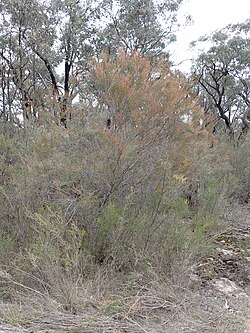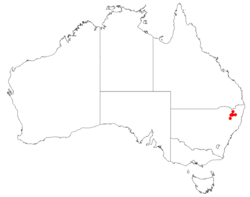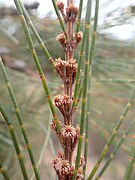Biology:Allocasuarina brachystachya
| Allocasuarina brachystachya | |
|---|---|

| |
| In Kings Plains National Park | |
| Scientific classification | |
| Kingdom: | Plantae |
| Clade: | Tracheophytes |
| Clade: | Angiosperms |
| Clade: | Eudicots |
| Clade: | Rosids |
| Order: | Fagales |
| Family: | Casuarinaceae |
| Genus: | Allocasuarina |
| Species: | A. brachystachya
|
| Binomial name | |
| Allocasuarina brachystachya L.A.S.Johnson[1]
| |

| |
| Occurrence data from AVH | |
Allocasuarina brachystachya is a species of flowering plant in the family Casuarinaceae and is endemic to the Northern Tablelands of New South Wales. It is an open, usually monoecious shrub that has branchlets up to 70 mm (2.8 in) long, the leaves reduced to scales in whorls of 5 to 7, the fruiting cones 7–14 mm (0.28–0.55 in) long containing winged seeds (samaras) 2.5–4 mm (0.098–0.157 in) long.
Description
Allocasuarina brachystachya is an open, spreading, usually monoecious shrub that typically grows to a height of up to about 3 m (9.8 ft). Its branchlets are more or less erect, up to 70 mm (2.8 in) long, the leaves reduced to erect, scale-like teeth 0.2–0.5 mm (0.0079–0.0197 in) long, arranged in whorls of five to seven around the branchlets. The sections of branchlet between the leaf whorls (the "articles") are 2–5 mm (0.079–0.197 in) long and 0.4–0.7 mm (0.016–0.028 in) wide. Male flowers are arranged in head-like spikes 5–17 mm (0.20–0.67 in) long, the anthers 0.3–0.6 mm (0.012–0.024 in) long. Female cones are covered with fine, white or dark yellowish hairs when young, and are sessile or on a peduncle up to 5 mm (0.20 in) long. Mature cones are 7–14 mm (0.28–0.55 in) long and 5–8 mm (0.20–0.31 in) in diameter, the samaras 2.5–4.0 mm (0.098–0.157 in) long.[2][3]
This casuarina is similar to Allocasuarina paludosa.[2]
Taxonomy
Allocasuarina brachystachya was first formally described in 1989 by Lawrie Johnson in the Flora of Australia from specimens collected by Karen Wilson near Tingha in 1980.[4][5]
The specific epithet, (brachystachya) means "short spike", referring to the male spikes.[2]
Distribution and habitat
This sheoak grows in low open woodland between Emmaville, Guyra and Moredun, on the western edge of the Northern Tablelands of New South Wales.[2][3]
Gallery
References
- ↑ "Allocasuarina brachystachya". https://biodiversity.org.au/nsl/services/apc-format/display/82224. Retrieved 14 May 2023.
- ↑ 2.0 2.1 2.2 2.3 "Allocasuarina brachystachya". Australian Biological Resources Study, Department of Agriculture, Water and the Environment: Canberra. https://profiles.ala.org.au/opus/foa/profile/Allocasuarina%20brachystachya.
- ↑ 3.0 3.1 Karen L. Wilson & Lawrie Johnson. "New South Wales Flora Online: Allocasuarina brachystachya". Royal Botanic Gardens & Domain Trust, Sydney, Australia. http://plantnet.rbgsyd.nsw.gov.au/cgi-bin/NSWfl.pl?page=nswfl&lvl=sp&name=Allocasuarina~brachystachya.
- ↑ "Allocasuarina brachystachya". APNI. https://id.biodiversity.org.au/instance/apni/499248.
- ↑ Wilson, Karen L.; Johnson, Lawrence A.S. (1989). Flora of Australia. 3. Canberra: Australian Government Publishing Service. p. 168. https://www.dcceew.gov.au/sites/default/files/env/pages/a08d125d-a6d0-47c4-85e9-9b7ac5d4931a/files/flora-australia-03-hamamelidales-casuarinales.pdf. Retrieved 15 May 2023.
Wikidata ☰ Q15375429 entry
 |




